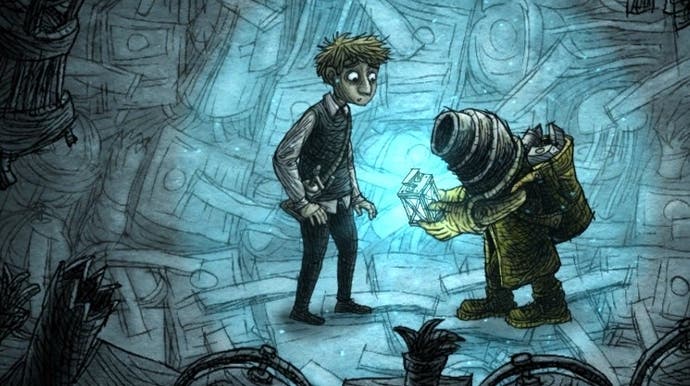Creaks review - great puzzles in an eerie underworld of living objects
Mind the furniture.
Amanita Design's latest is a game of vast but delicate imagination, at once rambling and toy-like. Released alongside a crop of triple-A games that demand to be played for days, Creaks has the soothing conciseness of a key fitting into a lock. Its entire world is visible on the main menu from the outset: a vast underground fortress, winding down from observatories and libraries to laboratories and submarine grottos. The protagonist, a charmingly timid man in shirt sleeves, stumbles into this strange, buried reality after crawling through a hole in his apartment wall.
As in the developer's celebrated point-and-clickers Machinarium and Samorost, this is more of a hoard than a world: a dingy trove of objects pilfered from the far corners of the Earth and the guts of history. It's as though somebody had turned Gormenghast into a wonder cabinet, packed with busted clocks and dinosaur skulls, mouldering books and statues, all drawn with a florid, impressionistic hand that seems positively allergic to straight lines. Also as in Amanita's other games, this is a world on the brink of destruction. Something enormous and angry is climbing around the exterior of the fortress, demolishing whole rooms with a sweep of its claws. A small flock of quaintly dressed bird-people are trying their best to dislodge it. You'll glimpse their comic efforts through gaps in the woodwork as you wander downward from puzzle to puzzle, seeking the route back to the surface.

The story is eerie but whimsical, a bedtime read for the kind of child who spies monsters in wallpaper patterns. It's told without words and is unhindered by any desire to explain the moving parts. The biggest twist is simply the protagonist dropping his torch during the descent from his apartment. This is decisive because as you soon learn, many of the castle's objects come to life in the dark. In the workshops near the summit, secateurs on hooks flex their jaws like butterflies testing their wings. Painted kites eye you with tigrish amusement. A setting that reminds you initially of Neil Gaiman's Coraline starts to feel like a coral reef, its heaps of bricabrac reacting gently to your passage.
Some objects are animate enough in shadow to be dangerous. Stubby chests of drawers transform into guard dogs, charging anybody who comes near their baskets, voices booming like the slam of filing cabinets. Ornamental globes become flying jellyfish, coasting left to right. Gushing drainpipes become snuffling elephant trunks. Chairs shapeshift into skittish goat-like creatures. Coatstands, rather terrifyingly, turn into thorny Halloween spectres who mirror your movements providing there's space to do so.
All of these creatures will kill you instantly if you bumble into them, but you'll need to "collaborate" with them to solve puzzles. Once safely neutralised by the glare of a ceiling lamp, objects can be dragged around to serve as platforms or used to weigh down pressure panels. Puzzles are rarely as straightforward as trying to petrify every last creature, however, and in any case, those lamps (some of which can be wirelessly activated, once you acquire a certain item) are few and far between. Typically you'll need to exploit their unnatural mobility, weaving a path for them by raising or lowering barriers, dropping bridges and, most satisfyingly of all, using other creatures as obstacles or provocations.

The dogs will chase after the goats, for instance, but are scared stiff of the jellyfish creatures. You can exploit this to pull them out of position while you're off doing something else, like pushing a button to raise the drawbridge between the dog and the area's exit. The jellyfish patrol horizontally, but always try to fly up or down a level when they bump into something. You'll often find yourself racing them around the screen, creating gaps for them as though arranging the track in front of a train. Sections featuring coatstands are about working out how to move two objects in parallel through different combinations of obstacles, tripping the lights to lock the dreadful thing in place so that you can alter the distance between you.
All of which might sound quite dry and mechanical. Creaks is anything but. The puzzle props are beautifully characterised, from the look of huggable dismay on a dog's face when it can't return to its basket, to the atrocious giggling of the coatstand creatures when you leave them idle. Necessary as it may seem to reduce them to sets of behaviours trapped in single-output logic boxes, I never stopped thinking of them as characters. I certainly never thought of them as enemies. Each creature's quirks also make the puzzles easier to read: the dignified way the jellies peer up and down when they meet a wall reminds you, for instance, that they'd always rather ascend than descend.
Creaks has other ways of teaching the player. As wonderful as the hand-painted levels are, with their balance of summery and funereal colours, stained glass windows glowing above shelves of dusty bone, the audio is more impressive. Each puzzle has its own track, and those tracks layer up as you progress through each puzzle - a tickle of piano, a deepening of the percussion, to let you know that you're heading in the right direction. It gives Creaks a momentum that might keep you plugging away to the end in a single sitting.

The real touches of genius, however, are probably the collectables. Tucked away in corridors and alcoves around the fortress are a series of opulent mechanical oil paintings featuring avian figures in period attire. Some of the paintings are just wind-up musical scenes, operated by yanking a chain. Others are full-blown mini-games, feats of faux-clockwork puppetry with buttons and levers around the frame. There's a panel-by-panel maze involving a lost cat, an endless runner, a sword-fighting game, even a playable opera recital. None of these minigames are challenging - they're just arcane baubles to keep your brain ticking over between logic puzzles - and there's no reward for playing them beyond the sheer joy of doing so.
Creaks shouldn't take you longer than 10 hours to finish. Shortly before the conclusion you're treated to an elevator ride back up through the fortress, passing many of the puzzles you've wrestled with in reverse. It's a nice way to sum up, as though the player's path were a bow tied around the world, but what pleased me most about this retrospective tour was that I didn't need it. The bits and pieces of those conundrums were still fresh in my mind, like I'd polished them off moments before. That kind of clarity is rare, especially in the context of such tumbledown art direction. If you're weary of exhaustingly inexhaustible blockbusters, I'd set aside some time for Creaks. It won't ask for much, and it gives so much in return.











